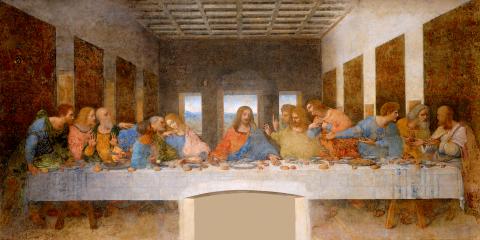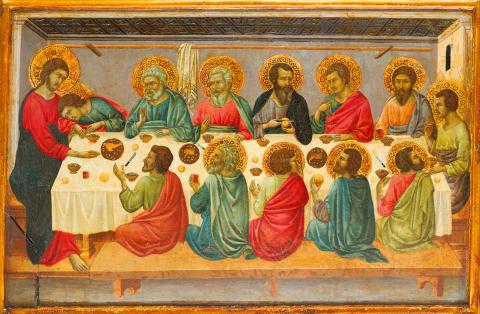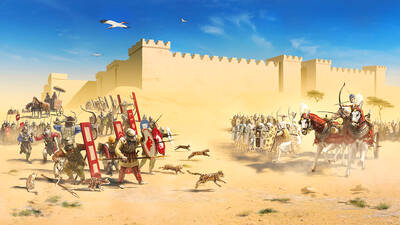The scene of the “last supper” is one of the best known of the Bible, depicting how Jesus Christ shares an evening meal with his 12 disciples. During the meal, Christ predicts that one among them — it turns out to be Judas Iscariot — will betray him. Sure enough, the very next day Christ is arrested by Roman soldiers. He would later be crucified.
The most famous work depicting this scene is Leonardo da Vinci’s (1452-1519) painting The Last Supper (photo 1). The more traditional composition representing a group meal is to have the guests arranged in a circle (photo 2), as was the convention, and yet da Vinci has chosen to pull open this closed circle and present it in a more linear form, with Christ in the center and the other guests to one side of the long table, and the other side open to the viewers. Christ is extending his arms with the palm of his left hand facing up, as if he were inviting the viewer to take a seat at the table.
On hearing Christ’s revelation that he is to be subjected to suffering, and be betrayed by one of the disciples, the group becomes agitated and unsettled. Da Vinci paints each individual in a dramatic pose, displaying surprise, distress, concern and perplexity, painting them in very life-like postures and facial expressions.

Photo: Wikimedia Commons
照片:維基共享資源
The disciple to Christ’s left, from the viewer’s perspective, has a particularly ashen complexion, their posture expressing profound sorrow. Some have attributed the rather feminine depiction of the figure here to Da Vinci’s homosexual orientation, and in fact Dan Brown, in his novel The Da Vinci Code goes as far as to suggest that this disciple is actually a woman, identifying her as Mary Magdalene and saying that she is actually Christ’s wife.
In fact, in traditional depictions of John the Disciple, he is often represented as a fresh-faced youth, in slightly effeminate or feminine poses, or sometimes as androgynous. This was even more common in Medieval Western European art, and can be traced back to fourth century Rome. The clue to this phenomenon is possibly found in the Bible, where Christ tells the disciples that one among their number will be his betrayer, there was “one of His disciples, whom Jesus loved” who, “leaning back on Jesus’ breast, … said to Him, “Lord, who is it?” (John 13:23-25). The phrase “whom Jesus loved” only appears in the Gospel of John, and is not found elsewhere in the Bible, and yet it appears six times in that gospel. The identity of the disciple “whom Jesus loved” is not explicitly mentioned, although the Christian Church has traditionally held it to be the Apostle John, who wrote this particular gospel.
Jesus had specifically commented on genders falling outside of the clearly demarcated male or female forms. In Matthew 19:11-12 (King James Version) for example, Jesus speaks of eunuchs:

Photo courtesy of Metropolitan Museum of Art, US
照片:美國大都會博物館提供
But he said unto them, All men cannot receive this saying, save they to whom it is given.
For there are some eunuchs, which were so born from their mother’s womb: and there are some eunuchs, which were made eunuchs of men: and there be eunuchs, which have made themselves eunuchs for the kingdom of heaven’s sake. He that is able to receive it, let him receive it.
Despite the fact that he did not comply with conventional masculine gender stereotype, John was not only allowed to eat together with the rest of the men, he was also the disciple that was beloved by Jesus.
(Translated by Paul Cooper, Taipei Times)
「最後的晚餐」是聖經著名的場景,描述耶穌與十二門徒一起晚餐,席中耶穌預示,祂將被其中一位門徒(即猶大)出賣。耶穌次日果然遭羅馬士兵逮捕,最後被釘上十字架。
描繪此場景最著名的作品,便是達文西(一四五二~一五一九)的《最後的晚餐》【圖一】。眾人一起晚餐的傳統構圖方式,想當然耳,便是圍成一桌(例如【圖二】)。然而,達文西卻把這封閉的圈子打開,拉成水平一長條,以耶穌為中心,眾人分坐在長桌的一側,而另一側完全對觀者敞開,耶穌張開雙臂,就像是在邀請觀者入座。
聽到耶穌說祂將會受難,且是被門徒出賣,眾人頓時陷入騷動與不安。達文西讓每位門徒舉手投足都是戲——驚訝、傷心、憂慮、困惑,以生動的姿態表情顯露出來。
耶穌右手邊的門徒特別蒼白,身形柔軟顯得特別悲傷。這陰柔的描繪方式有人認為是因為達文西的同性戀傾向,而丹布朗的小說《達文西密碼》更穿鑿附會說這位門徒是女性,即抹大拉的馬利亞,且她實為耶穌之妻。
其實傳統上對使徒約翰的描繪,多是沒有鬍鬚的青年,形象較陰柔、女性化,甚至是雌雄同體。這在中世紀西歐藝術中更常見,並可追溯到四世紀的羅馬。之所以如此,或許可從《聖經》中尋得線索——耶穌說,你們這些門徒中,有一個人會出賣我,「有一個門徒,是耶穌所愛的」,倚在耶穌的胸膛上問說,「主啊,是誰呢?」 (〈約翰福音〉第十三章,第二十三至二十五節)。
「耶穌所愛的門徒」一詞,是〈約翰福音〉中所獨有的內容,未見於聖經其他部分。在〈約翰福音〉中出現了六次的「耶穌所愛的門徒」,其身份成謎,但基督教會傳統上認為,這是該福音書的作者約翰。
對於非男人、女人截然二分的性別形象,耶穌也曾特別提出,例如〈馬太福音〉第十九章第十一至十二節中,耶穌所說的「閹人」:
耶穌說:「這話不是人都能領受的,惟獨賜給誰,誰才能領受。因為有生來是閹人,也有被人閹的,並有為天國的緣故自閹的。這話誰能領受就可以領受。」(和合本中譯)
儘管不是陽剛的性別刻板形象,約翰不但被允許在這張大桌上與眾人同席共餐,他更是耶穌鍾愛的門徒。
(台北時報林俐凱)

A: In addition to “Mission: Impossible 8,” what other new movies are in theaters? B: “Final Destination: Bloodlines” and “The Wedding Banquet” are out. The French film “Jane Austen Wrecked My Life” will also open soon. A: The Final Destination horror movie series is so scary that I don’t dare watch it. B: Then how about “The Wedding Banquet,” which is a 2025 remake of the 1993 classic of the same title? Oscar-winning actress Youn Yuh-jung’s performance in it is highly anticipated. A: But as a fan of British writer Jane Austen, I’m more interested to see how her works

US President Donald Trump on Monday last week signed the TAKE IT DOWN ACT (Tools to Address Known Exploitation by Immobilizing Technological Deepfakes on Websites and Networks Act), bipartisan legislation that enacts stricter penalties for the distribution of non-consensual intimate imagery, sometimes called “revenge porn,” as well as deepfakes created by artificial intelligence. The measure, which goes into effect immediately, was introduced by Sen. Ted Cruz, a Republican from Texas, and Sen. Amy Klobuchar, a Democrat from Minnesota, and later gained the support of First Lady Melania Trump. Critics of the measure, which addresses both real and artificial intelligence-generated imagery, say

Cats ruled in ancient Egypt—and not just in their own minds. These clever, graceful creatures were so deeply respected by the Egyptians that harming one could lead to severe punishment, even death. But why did the Egyptians hold cats in such high regard? It wasn’t just because they were cute; cats played a crucial role in protecting the country’s grain stores from pests. As guardians of Egypt’s food supply, they were seen as sacred animals. The Egyptians honored them through Bastet, the cat-headed goddess of protection, the home and fertility. Egyptians didn’t just love cats; they worshipped them. Cats lived in luxury,

A: Wanna go see a movie during the three-day weekend for the Dragon Boat Festival? B: Sure, I wanna see “Mission: Impossible – The Final Reckoning.” A: Rumor has it that this may be actor Tom Cruise’s last mission with the Mission: Impossible action movie franchise. B: Tom was only 34 when the first installment of the series was released in 1996. Now, he’s 63 and the eighth installment is out. A: I hope he’ll stay with the series. Let’s go see him fight against AI this weekend. A: 端午節三天連假週末要不要去看電影? B: 好啊我想看 《不可能的任務:最終清算》! A: 這有可能是湯姆克魯斯最後一次為動作片《不可能》系列出任務。 B: